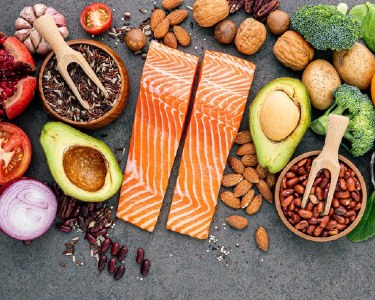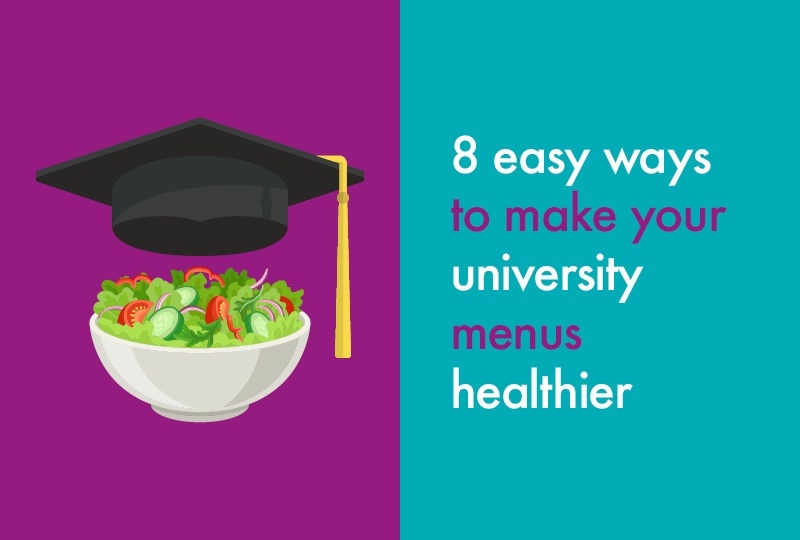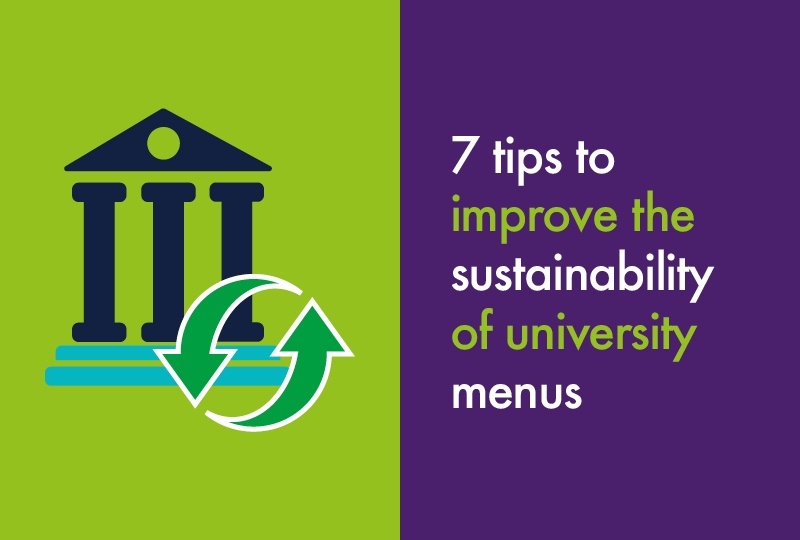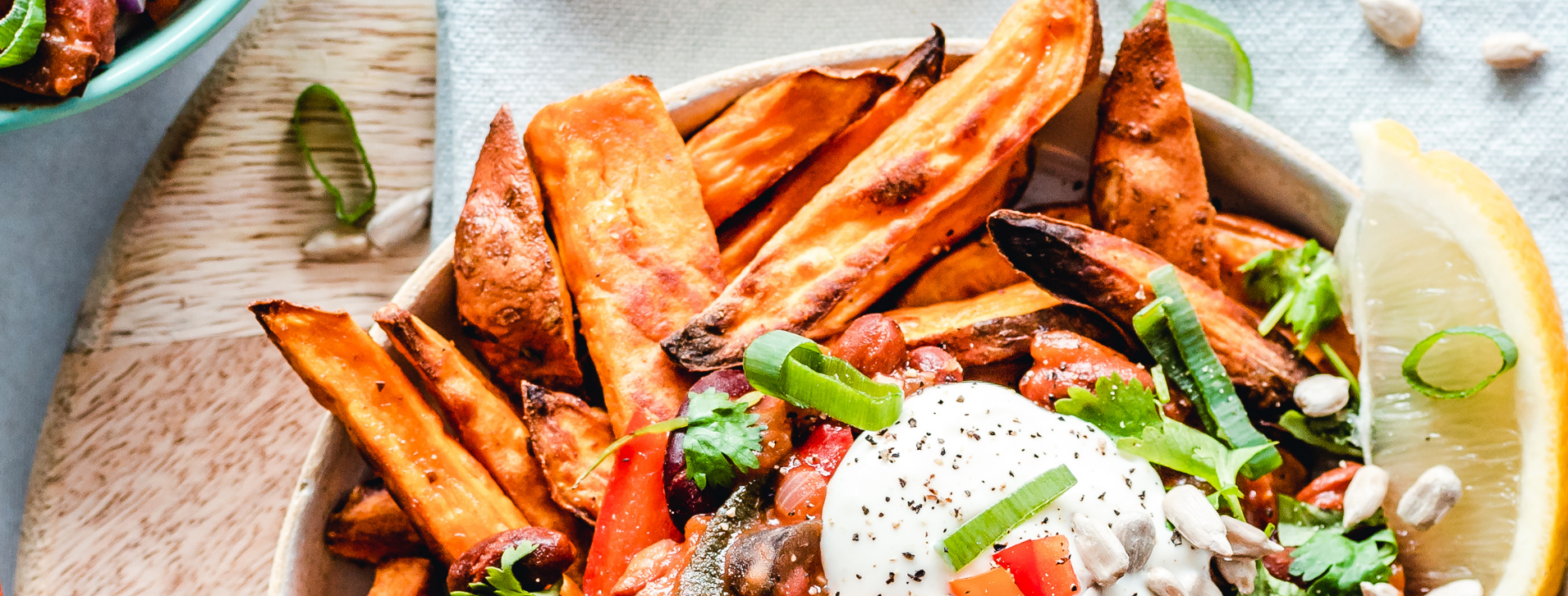Healthy and sustainable diets is a concept that is becoming more common to hear about and see in menu innovation – and for good reason! Overall as a nation, we are consuming more calories than we burn, leading to an obesity crisis. According to the latest Health Survey for England, 2021, 26% of adults are obese. However, only 8% of younger adults aged 16-24 are obese.
The current generation of university students are appearing to be more health conscious than their predecessors. Among this age group obesity is flat-lining and reported consumption of alcohol is decreasing too1. Not only this, but they are more open to change, leaving an opportunity to inspire and educate them in embedding health into their diets. The latest data also shows that UK consumers are increasingly looking to adopt more healthy and sustainable diets, with 58% open to changing their eating habits2.

This is why health and nutrition should be a primary focus for any menu development within universities. Below are eight ways to create menus of the future with health in mind:
1. Minimise portion size and focus on the nutritional content, not the calorie number
By reducing the portion size of the food you will be reducing the number of calories being served from that dish. This is a great and effective way to support consumers to reduce their calorie intake from a single serving. Plus this approach will also likely reduce the food waste from leftover food on the plate, helping out the environment too.
But calories are not the be-all and end-all. Foods can be low in calories but nutritionally offer very little to the body. Food is vital for health, for example, the body requires fat to help us absorb some vitamins such as A, D, E and K, protein has a large variety of roles in organs, the antibodies in our immune system and the haemoglobin that carries our oxygen in the blood, and carbohydrates are an important source of fibre.
Then there are the wide array of vitamins and minerals the body needs to function well that are essential micronutrients, meaning we must get them from our diet. As such, we should be challenging the concept that the most important thing is the calorie number of the dish when it comes to health.
Price is often a leading factor when deciding what foods to pick, especially for students sticking to a strict budget. But value for money does not have to be just about the quantity you get but the quality of the food. So shout about the nutrition and health benefits of the food being provided with transparent nutrition information.
Use signage to highlight if a food is high in protein or a source of fibre, or when a meal contributes to one of your 5-a-day. Let them know that healthy eating can be both tasty and budget friendly.
At Bidfood, we capture the nutrition information for both our own brand and branded products. This information can be found in a number of ways, from the packaging, product specifications, our Advice Centre nutrition reports and also online on Bidfood Direct. On top of this, Bidfood Direct has a MyRecipes tool which can nutritionally calculate recipes per 100g and per serve, assisting you to communicate with your consumers on the nutritional composition of the food on offer.
2. Diversify the produce on your plate
This leads on very well on from focusing on the nutritional content, not the calorie number.
Fruit and vegetables are an important part of a healthy balanced diet. In addition to this, research from IGD shows that eating more fruits and vegetables is the top aspiration when it comes to health priorities for shoppers.
Try to think about produce first when developing menu plans and increase the diversity to broaden the range of nutrients being provided by each dish and keep recipe innovation exciting. Plus, studies show that the more variety in plant foods consumed, the more you are also supporting your gut microbiome.
Scratch cooking is a great way to incorporate a variety of produce into a meal, whilst minimising ultra-processed foods and giving the ability to reduce the salt and added sugar content of the foods too.
Another approach could be to incorporate more seasonal fruit and vegetables. This is not only an innovative way to diversify the produce being provided but it can also support UK farmers and minimise food miles, so potentially supporting the environment too.
3. Build recipes where legumes and nuts are the focal point of the plate
Plant protein alternatives are becoming more popular on menus, not just for vegan and vegetarian consumers but also for flexitarians, with 39% of consumers now stating that they only consume meat twice a week or less2. We had similar findings in our Food & Drink Trends 2023 research, read more here.
There are many reasons for this shift in consumer habits, including perceptions in the impact this has on the environment, cost and health.
High intakes of red and processed meat are associated with an increased risk in bowel cancer, for example3. So try to reduce red meat and processed meat on the menu and look to replace with plant proteins such as legumes, like beans, peas and lentils, and nuts as the main component of the meal, which are also good sources of protein and other nutrients such as Vitamin B1, folic acid and iron.
Moving away from conventional protein sources such as meat will also have a positive impact on the environment, as many studies show that meat has a higher carbon footprint than what most plants do. In addition, nuts and legumes have a small carbon and water footprint and are great for the soil, reducing the need for fertilisers.
Bidfood has launched its own Meat Free Space, home to our collection of vegetarian, vegan and plant-based products that will help you deliver the very best meat free options to your customers. Go visit our site to see what products could support your plant based innovation and gather inspiration from our favourite vegan recipes too such as our African peanut stew and our smokey nomince expresso chilli.

4. Normalise wholegrains
Fibre is very important in our diets for things like keeping our digestive system healthy. In the Scientific Advisory Committee on Nutrition (SACN) report into carbohydrates and health recommendations were made for adults to consume 30g of dietary fibre per day, to have the greatest health benefits in reducing the incidence of cardiovascular disease, type 2 diabetes and colorectal cancer. However the latest figures suggest the average fibre intake for adults is 18g per day.
Wholegrains are a great way to increase the fibre intake of food, and other nutrients. Refined grains are made from milling the wholegrain and removing the bran and the germ, which are fibre-rich and nutrient-packed. Wholegrains can contain up to 75% more nutrients than refined cereals, providing more fibre along with B vitamins, antioxidants and minerals like copper and magnesium4.
If we want to improve people’s consumption of fibre and reduce the risk of many common diseases, wholegrains shouldn’t be perceived as the ‘healthy meal’ option on the menu for just the ‘health conscious consumer’. So why not challenge the norm and make wholegrains the standard on menus and refined grains the exception? Nudging tactics can go a long way.
Offer wholegrain wraps, pasta, rice and sandwiches as the standard, then consumers can request if they wish to have refined grains as an alteration.
5. Choose good fats
For years, fat has been under the spotlight and linked with many health conditions such as heart disease and stroke and rightly so for saturated fats that are found in foods like fatty cuts of meat, processed meat products, cheese, cream, butter, spreads, biscuits and pastries.
But good fats, such as unsaturated fats are important to have in the diet and are actually associated with lowering blood cholesterol, which is linked to heart disease and stroke, when used as a replacement for saturated fats5.
These good fats should not be treated in the same manner as bad fats and a healthy and balanced diet shouldn’t be prioritising low fat but thinking about what kind of fat can be added to the dish for health benefit purposes. Sources of unsaturated fats include rapeseed or olive oil, seeds, nuts, avocados and oily fish.
Try swapping animal derived fat spreads and butters, with rapeseed, vegetable or olive oils and spreads. If looking for a meat protein source, look to have salmon, mackerel or trout instead of processed meat like bacon and sausages. And to add texture to foods like salads, add nuts and seeds as a topping. These unsaturated fats contain essential fatty acids omega-3 and omega-6, which will help the nervous system and brain keep healthy6.

So far we have discussed what you can add that nutritionally benefits people. But it is also good to remind ourselves of the things we should be having less of, which is why the last three tips talk about what to reduce.
6. Reduce salt intake – delicious flavours don’t need to be built around it
In the UK we have on average 8.4g of salt per day when we should eat no more than 6g, that’s a whopping 40% more! Too much salt in your diet is linked to high blood pressure, which is the leading modifiable risk factor for cardiovascular disease7. So it is important to think about the salt already added to pre-made foods and what is being added in the cooking process.
Some quick wins to reducing the salt served in dishes include making sure any tinned products, such as beans and pulses, are stored in water rather than brine and selecting low/reduced salt product options instead of the original.
Moreover, delicious flavours can be built with minimal salt, if any. Try developing the flavours from the ground up by using spices, herbs, citrus and other aromatic flavours. Foods can be infused or marinated to really embed the flavours within the food.
At Bidfood, we have made a to work towards the government’s 2024 salt targets within our own brand range. Information on the salt content of all foods can be found on packaging, product specifications, our Advice Centre nutrition reports and also online on Bidfood Direct.
7. Watch out for added sugars
In SACN’s report into carbohydrates and health they also concluded that adults and children were consuming too much free sugars, such as added sugar in foods, honey, syrups and fruit juices. It is recommended that free sugar should not contribute to more than 5% of the total dietary energy in a day, which is about 30g for adults. Consuming too much sugar can have a detrimental impact to health and increase your risk of type 2 diabetes and tooth decay.
It’s surprising where added sugar can be found in foods, like condiments, pasta sauces, yogurts, breakfast cereals and beverages, not just in the food that you expect to be high in sugar like cakes, biscuits and sweets.
Always check the nutrition information on products. You can check to see how much sugar is in a product by looking at the back of pack nutrition table for the ‘carbohydrates of which sugar’ value and if you want to know if it contains added sugar have a look to see if any sugars or syrups are in the ingredients list.
And, again quick wins for reducing sugar can be to select tinned products, such as fruit, that are stored in fruit juice and not syrup. Plus purchase low/reduced and no added sugar options for products, like cakes, condiments and tinned goods liked baked beans.
Try to sweeten foods naturally, adding whole or pureed fruit is a great way to do so. Even though fruit does contain sugar, it then also comes with an array of vitamins and minerals, along with fibre, that you won’t get from refined sugar. Substituting veg in bakery products like cakes can also add natural sweetness meaning less added sugar is needed to contribute to the overall sweet taste. For recipe inspiration, have a look at our cocoa beetroot brownie and our raspberry and apple cake recipes.
8. Reduce sugary beverages
And finally, leading on from our tip on added sugars, try to reduce sugary beverages. Many of these drinks are considered to be ‘empty calories’, where the sugary content of the drink contributes to overall calorie intake but provides little to no nutritional benefit.
Just to be aware too, some studies suggest that diet drinks can cause consumers to want to eat more, so try to diversify the drinks options to drinks flavoured with natural ingredients that aren’t so sugary and sweet to taste.
There are so many new innovative drink products coming onto the market that focus on natural sweetness and also no-alcohol options, which could be really popular with the student market. Why not try Feel Good’s Raspberry and Hibiscus Fruitful Sparkling Water Can or Nix & Kix’s Mango and Ginger drinks. Both drinks flavours are built around carbonated water infused with natural ingredients to make their great flavours and have no added sugar.
All information on branded and own brand drinks, including drinks that are below the remit of the Soft Drinks Industry Levy, can be found on our Traffic Light Food report, just ask our Advice Centre for a copy.
So there you have it, 8 tips to make your university menu healthier. Remember that it’s not just about what you take out of a recipe that can make it healthier but more importantly what can be added too!
For more information and guidance on healthy and sustainable diets go to our ‘Menus of the Future’ hub.




